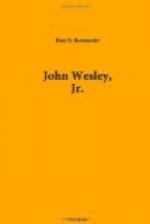“Then let’s get together a few people to-night after prayer meeting. Our pastor, of course, and the editor of the Dispatch—he’s the right sort, if he does boost ‘boosting’ a good deal; and Miss Leigh, of the High School—she’s all right every way; and Mrs. Whitehill, the president of the Woman’s Association of our church—that’s the women’s missionary societies and the Ladies’ Aid merged into one—she’s a regular progressive; and Harry Field, who’s just getting hold of his job in the League; and the Sunday school superintendent. That’s dad, you know; he’s had the job for a couple of years now, and he’s as keen about it as Harry is over the League.”
They got together, and out of that first simple discussion came all sorts of new difficulties for Delafield Methodism to face and master.
* * * * *
Manford Conover was a preacher with a business man’s training and viewpoint. He may have mentioned his official title, when he first appeared, but nobody remembered it. When people couldn’t think of his name he was “the man from the Board,” which was all the same to him.
After that first night’s meeting Conover gave several days to walks about Delafield. J.W. had found the shacks and the tenements, and Joe Carbrook had introduced J.W. to Main Street, but it was left to Conover to show him Europe and Africa in Delafield.
There’s a certain town in a Middle Western State, far better known than Delafield, rich, intelligent, highly self-content. Its churches and schools and clubs are matters for complacent satisfaction. And you would be safe in saying that not one in five of its well-to-do people know that the town has a Negro quarter, an Italian section, a Bohemian settlement, a Scandinavian community, a good-sized Greek colony, and some other centers of cultures and customs alien to what they assume is the town’s distinctive character.
They know, of course, that such people live in the town—couldn’t help knowing it. Their maids are Scandinavian or Negro. They buy vegetables and candy from the Greeks. They hear of bootlegging and blind tigers among certain foreign groups. The rough work of the town is done by men who speak little or no English. But all this makes small impression. It is a commonplace of American town life. And scarcely ever does it present itself as something to be looked into, or needing to be understood.
So Conover found it to be with Delafield. The “Everyday Doctrines” were well enough, but he knew a good deal of spade work must be done before they could take root and grow. He fronted a condition which has its counterpart in most American towns, each of which is two towns, one being certain well-defined and delimited areas where languages and Braces live amid conditions far removed from the American notion of what is endurable, and the other the “better part of town,” sometimes smugly called “the residence section,” where white Americans have homes.




